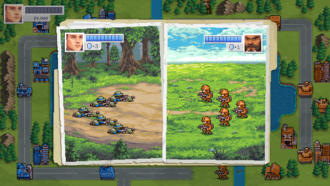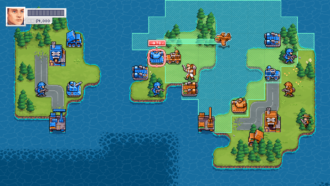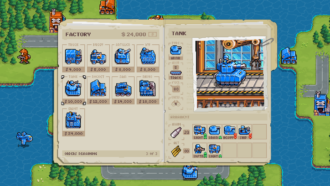Platforms:
PS4, PC, Nintendo Switch, PS5, Xbox Series X|S
Released:
April 16, 2025
Publisher:
First Break Labs
Developer:
LAVABIRD
While it’s almost 20 years since the world saw a brand new Advance Wars game (putting aside the seemingly great 2023 remake), a huge variety of indie game devs, likely spurred on by childhood nostalgia, have happily rushed to fill the spritely turn-based military void. Amidst the Wargroove’s, Tiny Metal’s and Into the Breach’s of the world comes Warside, a hardy but underbaked experience whose core gameplay engine may be revving well, but is let down by the rest of the chassis.
Warside is a turn-based top-down pixel art tactics game from developer LAVABIRD and publisher First Break Labs. It bills itself as a ‘fast-paced’ tactics game that discourages defence over fast and fluid skirmishes. Its campaign follows a range of warring factions fighting for control of a super-weapon across various biomes and commanders. Currently, Warside also contains a map editor and multiplayer mode for local and online PvP – the developers have also promised that a skirmish mode and co-op campaign are also in the works, though that is not being factored into this review.
Despite being a long-time lover of turn-based tactics games (XCOM, my beloved), I haven’t played Advance Wars nor many of its contemporary continuations. This means that I came to Warside with a broad rather than specific appreciation for the genre, and from that perspective, I found its tactical core solid. While it’s not going to offer anything new or innovative, particularly to fans of this particular subgenre, I found myself settling into a familiar groove of countering the AI, skirmishing back and forth, determining unit combinations and overall moving through its core campaign at a satisfying pace.
While I can’t speak to how it compares to its inspirations, I found Warside’s claim of supporting fluid skirmishes over defensive lines to be fairly accurate. Its economy pushes you to progress forward and grapple over buildings, consider how you accumulate currency to buy more units, constantly think about reinforcements, and adapt to changing battle lines. While I inevitably prioritised some over others, each unit plays a key role on the battlefield that complements one another, and leads to a fairly diverse and dynamic army and combat. The best parts of Warside were juggling infantry, armour, air and sea conflicts all at once, with each battle overlapping and feeding into the larger war.
“The best parts of Warside were juggling infantry, armour, air and sea conflicts all at once…”
On normal difficulty, I didn’t find any particular mission especially challenging, though they nonetheless have a natural ramp-up in intricacy over the campaign as more units and terrains have to be contended with. The AI is similarly competent at prioritising key targets, buildings, and even flanking at times. The paper, scissors, rock of tactics games is alive and well here too, with most units having clear and effective counters that need to be considered, and the AI also tended to be effective at utilising these counters. One area where the AI struggled was effectively fencing its territory, however; a few times I found it a bit too easy to ship some infantry across a quiet part of the map to contest buildings without ever drawing attention or resistance.
Regarding visual design, Warside wears its influence on its pixel chassis. It’s crisp and effective; each unit is visually distinct, environments are very readable, and the combat animations are satisfying (if a little long). There isn’t a huge variety to the maps – all the basic biomes are here and little else – but they at least change it up when it comes to terrain like roads, chokepoints, islands, coastlines and more in key missions. The UI is clean and unobtrusive too, and determining which units are yet to move and the current state of the battlefield was consistently easy and helped keep the pace flowing (though this becomes less true as the scale increases in later missions). The lack of an undo button for misclicks or mistakes is frustrating, though – it led to me restarting entire missions just to avoid the consequences of hitting the wrong square inadvertently.
Outside of the battlefield, though, Warside’s exterior begins to creak. The campaign’s design, outside of a few standout missions, is unremarkable and repetitive, often relying on too many objectives that boil down to ‘eliminate all enemies’ with little variety. Despite containing four colour-coded factions and a range of commanders, they rarely play differently enough from one another. Each faction contains only a single unique unit that barely varies tactics, and while each commander has a different unique power, they also aren’t likely to make you play that differently between missions.

While evidently not a priority, the campaign’s story is particularly poor, too. The dialogue is rote, characters only have a single portrait, plot progression feels drawn out and offers few surprises, and the story beats struggle to get properly integrated into individual mission designs. The plot follows the typical conventions of warring factions with petty grievances fighting over important weapons and taking cheap pot shots at one another. But hey, if you want to see a commander quote a Star Wars prequel meme that was tired a decade ago, Warside has you covered there.
Without spoiling anything (as much as there is to spoil), the campaign’s ending is also so weird and abrupt that it made me assume there were more missions, to the point I immediately began googling perplexedly afterwards to figure out if I missed something. Based on the longplays I checked, not only was I not alone in my puzzlement, but I hadn’t. Making this even more confusing is how Warside boasts of 30+ campaign missions in its promotional materials, whereas I only counted 23 by its end. Not that it’s a problem for its campaign to be slightly shorter, but it nonetheless made for a strange and deflating end, that perhaps speaks to more content to come, but for now left a sour final note.
Outside of the campaign, Warside also contains a multiplayer mode and map editor. The multiplayer mode allows for private and public matches, and the games lobby is a nice touch, but the choice of maps and commanders is strangely limited. The map editor, in contrast, is quite intuitive to use, and I could see myself spending some time putting together some unique designs if I could play them properly with friends or AI, but the lack of a basic skirmish mode for a quick tactical fix saps most of my motivation. It speaks to how oddly barebones the game is at launch – if it weren’t for the campaign being (mostly?) there, I would have assumed this was an Early Access release.
On a more positive note, though, it at least doesn’t have the technical difficulties that its sparseness might suggest. I played Warside on Steam Deck, and it did a great job recapturing a bit of that old handheld strategy game feel. While its first major update mentioned a range of game-breaking bugs and issues, I encountered none in my playthrough, leaving me with the impression that the game is either relatively polished now, or I was just lucky.
6.5
Decent
Positive:
- Promising core tactics
- Classic pixel art
Negative:
- Unremarkable campaign
- Lack of modes
Warside is like an old family car (tank?). Familiar, sturdy, with a solid engine that will get you where you need to go, but with no frills and a rusty, barebones exterior. While its core tactical systems and pixel art aesthetics are entertaining and likely to satisfy subgenre fans, they remain underserved by a repetitive campaign, rough story and lack of supporting modes and features.











